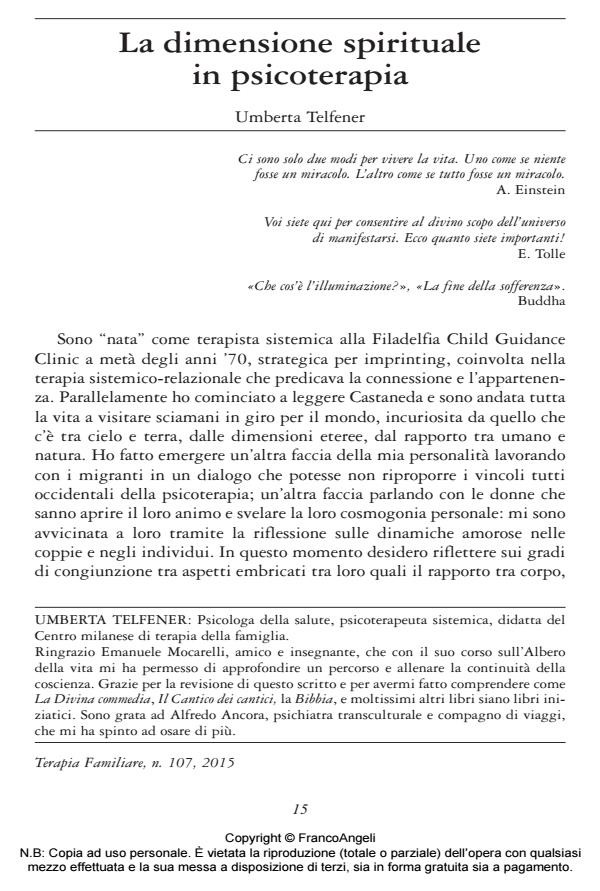La dimensione spirituale in psicoterapia
Journal title TERAPIA FAMILIARE
Author/s Umberta Telfener
Publishing Year 2015 Issue 2015/107 Language Italian
Pages 22 P. 15-36 File size 114 KB
DOI 10.3280/TF2015-107002
DOI is like a bar code for intellectual property: to have more infomation
click here
Below, you can see the article first page
If you want to buy this article in PDF format, you can do it, following the instructions to buy download credits

FrancoAngeli is member of Publishers International Linking Association, Inc (PILA), a not-for-profit association which run the CrossRef service enabling links to and from online scholarly content.
I consider in the article the possibility of another dimension to which to pay attention in the relationship with clients. I propose the spiritual dimension as an aspect which we must at last consider and I hypothesize some operations which enhance its emergence in psychotherapy. This dimension has become essential for me as a point of arrival of my personal journey and it is made possible after a long time of discipline and rigor.
Keywords: Spirituality, clinical practice, epistemological rigor, clinical proceedings
- Ancora A. (2006). I costruttori di trappole del vento. Milano: FrancoAngeli.
- Bateson G. (1972). Steps to an Ecology of Mind. San Francisco: Chandler Publishing Company (trad. it.: Verso un’ecologia della mente. Milano: Adelphi, 1976).
- Bateson G., Bateson M.C. (1988). Angels Fear, Towards an Epistemology of the Sacred. New York: Mc Millan (trad. it.: Dove gli angeli esitano: verso un’epistemologia del sacro. Milano: Adelphi, 1989).
- Bianciardi M. (2010). Evoluzione del pensiero sistemico e pratica clinica. Riflessioni sistemiche, 2. Testo disponibile al sito: http://www.aiems.eu/archivio/2_numero.html
- Bianciardi M. (2012). Il soggetto etico. In: Bianciardi M., Galvez Sanchez F. (a cura di), Psicoterapia come etica. Torino: Antigone, pp. 63-73.
- Bianciardi M., Telfener U. (2014). La psicoterapia come pratica ricorsiva. Torino: Bollati Boringhieri.
- Callieri B. (1995). Spiritualità e misticismo: l’inquieto confine tra religioni e psicologia. Attualità in psicologia, X, 4: 291-302.
- Castaneda C. (1968). The Teachings of Don Juan: A Yaqui Way of Knowledge. The University of California Press (trad. it.: A scuola dallo stregone. Roma: Astrolabio, 1970).
- Einstein A. (1949). The World as I See it. New York: Citadel Paperback.
- Eisler R., Montuori A. (2003). The Human Side of Spirituality. In: Giacalone R.A., Jurkiewicz C.L. (eds.), Handbook of Workplace Spirituality and Organizational Performance. New York: M.E. Sharp Inc., pp. 46-56.
- Goleman D. (1988). The Meditative Mind. New York: Putnam.
- Gurdjieff G.I. (1963). Meeting with Remarkable Men. Boston: E.P. Dutton & Co. (trad. it.: Incontri con uomini straordinari. Milano: Adelphi, 2008).
- Hanh T.N. (1991). The Miracle of Mindfulness. Fort Miers, FL: Rider.
- KabatZinn J. (1994). Mindfulness Meditation for Everyday Life. New York: Piatkus Books.
- Kazuyoshi Nomachi (2013). Le vie del sacro. Mostra itinerante del National Geographic.
- Kenny V. (1998). La dimensione del sacro in Bateson, cosa ci può insegnare per vivere costruttivamente? Oikos, 6.
- Linehan M. (1993). Skills Training Manual for Treating Borderline Personality Disorder. New York: Guilford Press.
- Madonna G. (2013). La psicoterapia attraverso Bateson, verso un’estetica della cura. Milano: FrancoAngeli.
- Ram Dass (1974). The only dance there is. Garden City, N.Y.: Anchor books.
- Restori A. (2010). La consapevolezza nelle relazioni d’aiuto. Cambiamenti, 1: 6-9.
- Sheldrake R. (2008). Morphic Resonance. The nature of formative causation. Bethel, Maine: Park Street Press.
- Segal Z., Williams J.M.G., Teasdale J. (2002). Mindfulness Based Cognitive Therapy for Depression. New York: John Wiley & Sons.
- Senge P., Scharmer O.C., Jaworski J., Flowers B.S. (2004). Presence. New York: Ramdom House.
- Suzuki D.T., Fromm E., Martino, R. (eds.) (1970). Zen Buddhism & psychoanalysis. New York: Harper and Row (trad. it.: Buddismo zen e psicoanalisi. Roma: Astrolabio, 1978).
- Telfener U. (2011). Apprendere i contesti, strategie per inserirsi in nuovi ambiti di lavoro. Milano: Raffaello Cortina.
- Tolle E. (1997). The Power of Now. Vancouver: Namaste Publishing (trad. it.: Il potere di adesso. Milano: Armenia, 2004).
- Varela F., Thompson E., Rosch E. (1991). The Embodied Mind. Cognitive Science and Human Experience. Cambridge: The Massachussetts Institute of Tecnology (trad. it.: La via di mezzo della conoscenza. Milano: Feltrinelli, 1992).
- Zolla E. (1981). Archetypes. Londra: Allen & Unwin (trad. it.: Archetipi. Venezia: Marsilio, 1988.
- Zolla E. (1989). Le potenze dell’anima, anatomia dell’uomo spirituale. Milano: Bur, 1991.
- Walsh F. (2010). Spiritual diversity multi-faith perspectives in family therapy. Family Process, 49 (3): 330-48.
- Watts A. (1961). Psychotherapy East & West. New York: Pantheon Books.
- Systems thinking: fostering collaboration and connections to strengthen the field. A conversation with Umberta Telfener Deisy Amorin‐Woods, Umberta Telfener, in Australian and New Zealand Journal of Family Therapy /2024 pp.109
DOI: 10.1002/anzf.1577
Umberta Telfener, La dimensione spirituale in psicoterapia in "TERAPIA FAMILIARE" 107/2015, pp 15-36, DOI: 10.3280/TF2015-107002